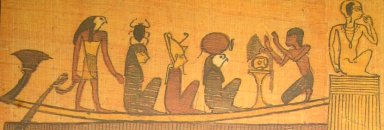
Mummification Process
The term “mummy” comes from the Arabic word ‘mumiya’ meaning “a body preserved in bitumen”. This has led to the popular misconception that a mummy was embalmed by treatment with the substance. As we now know bitumen was not normally used in the process at all. A number of early classical accounts exist describing mummification but the information is sometimes inaccurate and is based on the mummification techniques of about the 5th century BC.
It took seventy days between death and interment to prepare the corpse for burial. Half of this time had to be devoted to the drying process. The embalmers' first task was to remove the parts which would decay first, the internal organs by making an incision in the left side of the chest of abdomen. The brain was removed by making a hole inside the nose.
It used to be thought that the body was then soaked for a long period in a bath of natron, a naturally occurring compound of sodium carbonate and sodium bicarbonate, although recent studies have shown it more probable that natron was used dry. This had the effect of efficiently dehydrating the body, dissolving body fats and leaving the skin supple.
The body was then padded, any incisions sewn up, and covered with a powerful protective talisman. The eye sockets were plugged with linen or set with artificial eyes. The body was then treated with resins, ointment and spices, and covered with bandages enclosing protective charms, the most important being the heart scarab. It was during the process of bandaging that the Egyptian embalmers tried to restore the original shape of the body. The internal organs were placed in four containers called Canopic jars with stoppers in the form of protective deities.

How To Wrap A Mummy
It took fifteen days to wrap a mummy. This was because every action was dictated by ritual and had to be accompanied by the appropriate recitation of spells.
Before the wrapping could begin, all the linen had to be collected together and arranged in stacks according to purpose. One would be of shrouds, usually the magical number of seven, another would be of padding, while yet another would be of lengths and lengths of bandaging. The longest could be up to 15 metres or 49 feet long and up to 20 cm or 8 inches wide.
For the best mummies an enormous amount would be required. It has been calculated that a mummy might use up to 375 square metres or 448 square yards of cloth. So great was the amount needed that for some burials cast-off domestic clothing, doths and household towels were used.
There is a funeral lament which mentions 'cast-off linen of yesterday' in which the dead now sleeps.
It was essential for the bandaging to be well done to ensure that the mummy was rigid and the right shape maintained. The dead body was first wrapped in a yellow shroud. The bandaging began at the extremities; the hands and feet with the toes and fingers being wrapped separately. Then from the right shoulder a long strip of linen was wrapped around the head and crisscrossed in a figure of eight pattern. The arms were then wrapped from hands to shoulders until they were bound to the torso. The bandaging then continued with wide body wraps from the head to feet. The mummy was then wrapped with one or more shrouds which had been dyed red with henna.
Between each layer molten resin was applied to make the wrappings stick together. Women were usually wrapped with the hands extended on the inner or outer thighs while dead men had their hands placed over their genital organs. There were however variations to this.

intro | home | egyptian mummies
shop | mummification process | mummy facts
mummy links|egyptian mummies exhibition
| egyptian mummy pictures | find us